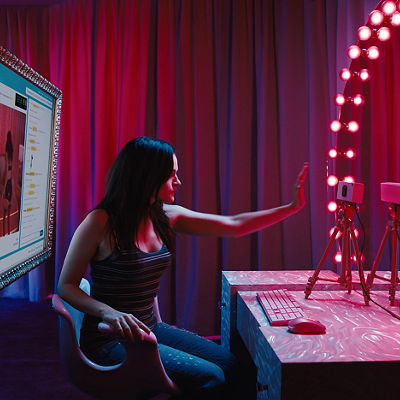The filmmaker -- whose most recent work, the 1992 Travellers, will close the festival this weekend. A professor and head of dramatic arts at Tehran University since 1973, Beizai, a playwright, critic, and reseacher as well as filmmaker, was for 10 years forbidden to direct theatre and for 20 to teach it. What brought this about was that he wouldn't toe the Iranian government's political line: "I told them I cannot refuse my father and mother and call them spies for Israel or America because I know they are not. They are my father and mother. And how can I refuse them?"
(Beizai learned English mainly by reading, and although he refused to believe that he speaks it clearly, even eloquently, he occasionally relied on translation by Rice media-studies professor Hamid Naficy.)
Born in 1938 and a descendant of four generations of poets, this member of the Iranian cinema and theatre vanguard said he doesn't really have to struggle to get his plays and screenplays published -- which becomes less surprising when you consider availability. According to Beizai, only 10,000 Iranians can afford to read: his written words are tolerated since there's a lack of widespread intelletucal readership. Producing his films and plays increases the chance that his thematics of "Who am I?" might incite people to explore where they stand in their culture; therefore, what's more difficult for Beizai to accomplish is bringing his texts to life. Accessibility poses a threat.
Commercial and state-supported Iranian filmmakers -- and their audiences -- must work around rigid censorship, governmental guidelines that make the Hays Production Code, which prescribed the moral content of American films from 1930 - 1966, seem like etiquette suggestions. "In the Hays era," Beizai explained, "they didn't tell you when to smile and when to put your head scarf on. They didn't dictate when to fall in love, when not to fall in love. . . . I and my audiences share a censorship code. They know how to read a film. They know that a woman who falls in love with someone or who goes to bed has to have her head scarf. She can't take her scarf off and be natural. . . . A husband and wife cannot hold hands; they have to hold two ends to a handkerchief."
The strict code often means that messages, commentaries, insights, sometimes even basic feelings, must be conveyed indirectly. Iranian moviemakers and -goers don't expect that "many things that happen in real life in a natural way" will appear on the screen. "For you who are used to seeing films which directly express emotions and relationships, this must be very strange."
Nowhere moreso than regarding the role of women. Iranian women are able to make films -- "as long as they have a male point of view, as long as they put out the official point of view. The moment they begin to express a personal point of view, they go under question."
umbersome as that is, to Beizai acting is the most difficult task for women in Iranian cinema -- and for the directors shooting them. Since much of women's faces are covered, "they can play only with one-sixth of their facial gestures" (which is why profile shots are rarely used: there's not much expressive to see). Head scarves also eliminate using hair to suggest mood and character change. "When you show from the back, for example, you only see a piece of cloth, not a person. . . . They cannot move very fast because if they do, then the contour of their bodies will show."
Technical problems compound filmmaking difficulties. Working on a 1:5 shot ratio prevents Iranian films from having the polish of Hollywood and independent features; American films, better financed than Iranian films, can go back for take after take if need be, while Iranian movies must make do with the best of the five. More problematic are the film crews: "Their capacity has a limit. Unfortunately, Iranians are a bit lazy. They hope that the director will not catch some of the mistakes that they make. . . . People are not used to being expected to perform perfectly. Iranians have learned from centuries past that in order to get along, you just rely on God, on the grace of God. If it didn't turn out well, maybe God didn't wish it."
Despite the problems he encounters, the very agreeable Beizai made a point of offering qualified hope for Iranian postrevolutionary cinema, though: "We are at a point of change. But the change hasn't occurred completely, so not everyone knows that they are responsible for their own fate, their own duties, their own work."
Travelers will show at 8 p.m. Friday, December 10, and at 7:30 p.m. Saturday, December 11, at the Museum of Fine Arts.





